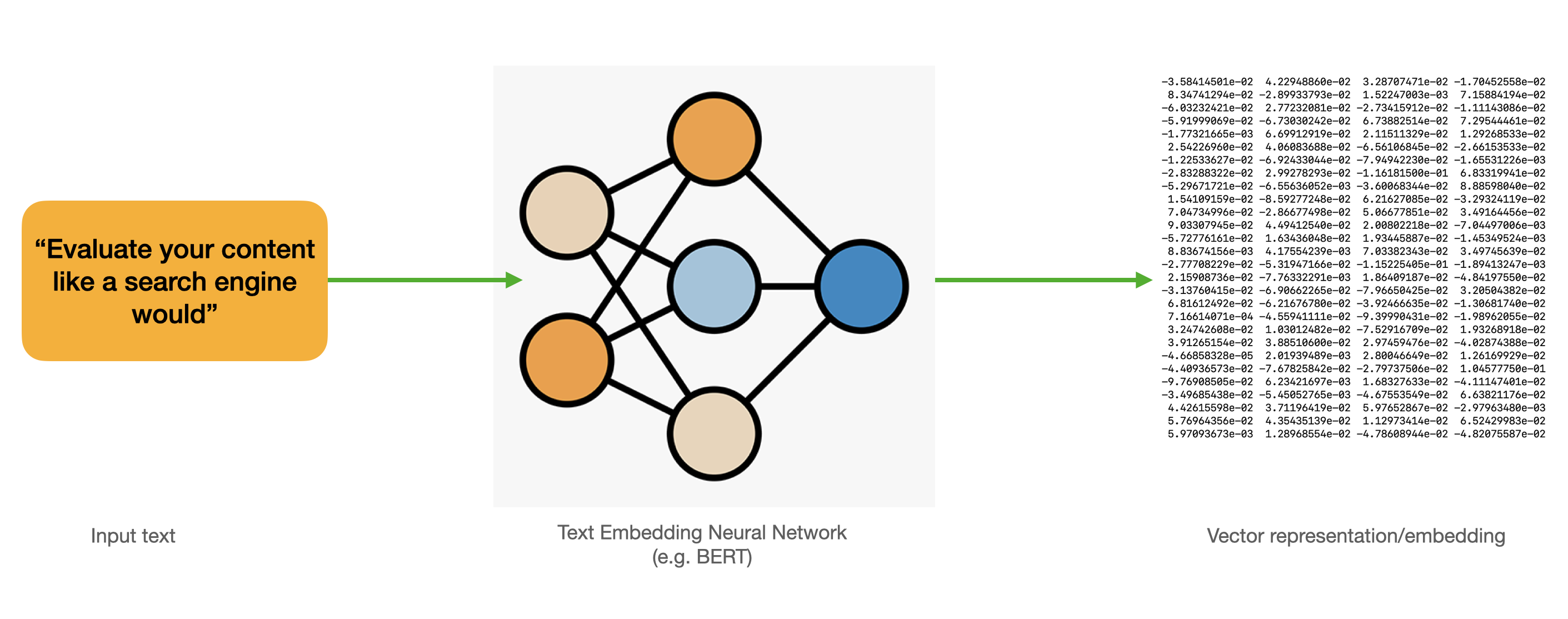Summary (TL;DR)
A semantics-driven approach to content SEO helps you overcome the limitations of a traditional keyword-based approach.
Semantic search uses mathematical representations of text called vectors to represent the meaning of text. This representation enables comparison of texts to understand their semantic relationships, especially similarity.
Applying semantic search to content SEO helps you focus on ideas and concepts related to a topic, and not on exact usage of specific terms. By using semantic search for content SEO, content can be topic-complete, while also being original and less cumbersome to read.
Find out how to apply semantic search to your content optimization.
Limitations of a keyword-based approach
The traditional approach to content SEO has been to identify terms from top-ranking pages through a variety of techniques, and then achieve a target keyword density for each of the extracted terms in your content (i.e. use a specific term a certain number of times).
However, search engines have recently increased their focus on semantics, i.e. the meaning of the ideas and concepts in your content and how well they relate to the search query, NOT on whether you use a specific keyword. Therefore, a keyword-based approach that relies on keyword density is no longer needed, and is not guaranteed to be optimal, because you are optimizing the wrong thing. This approach also often makes your content cumbersome to read and reduces its value for the reader.
Fortunately, by applying this very same semantic search technology to evaluate your content like a search engine would, you can avoid these limitations. Let's take a moment to understand the basics of semantic search.
How does semantic search work?
Semantic search is a way of searching based on the meaning of a piece of text (this could be a word, phrase, sentence or even a paragraph) using mathematical representations called vectors. The application of semantic search has increased exponentially over the last 4-5 years thanks to rapid advances in machine learning technologies. Specifically, the development and open-sourcing of Google BERT, which powers Google search, has enabled the widespread adoption of semantic search in NLP.
As an SEO, there are two important concepts that you should know about:
- Text embeddings: Text embeddings are mathematical vectors (think of an array of hundreds or thousands of numbers) that enable us to represent the meaning of a piece of text.
- Semantic similarity: Text embeddings can be compared for similarity, meaning you can figure out if they relate to the same broader topic, or if they are similar in meaning.

This means that while we type content in words of a language, search engines don't scan this text directly; instead, they process the vector equivalent of this textual data.
Here are a few immediate implications:
- Ideas/concepts vs keywords: Incorporating ideas and concepts related to the search keyword maximizes semantic relevance of your content to the search vector. Therefore, it is the most effective and most efficient content SEO strategy. A keyword-focused strategy optimizes for keyword density, and is therefore sub-optimal.
- Word count: Your content is mapped onto fixed-length vectors by search engines before comparison, so there is no required word count to rank. Your ideal content length is what 'YOU' need to speak to the important ideas and concepts.
- Content focus: Covering too many unrelated concepts on the same page will cause your content vector to be diluted, and confuse search engines. Don't do it.
With that short introduction, let us get a little deeper into how we can use the power of semantic search specifically for optimizing content, and avoid the disadvantages of using exact keywords.
Putting Semantic Search to use in Content SEO
To understand how semantic search is used in content optimization, let us look at the following picture:

Every content page that you create is mapped to a vector by search engines. Similarly, every query that is entered into a search engine is mapped to a vector.
The more semantically relevant your content is to the search vector, the closer you get to the search scope. Entering the search scope means you are considered semantically relevant to the search keyword. Importantly, the goal of content optimization is essentially one of maximizing the semantic relevance of your content to the user's search. Every single concept in semantic SEO builds from this.
As an example, consider the terms: [content marketing strategy, content marketing goals]. In the early days of search engines, you would need to use each of these terms in your content. Your content may have looked something like this:
"If you are trying to figure out what your content marketing strategy needs to be for the next few months, you really need to make a list of your content marketing goals first"
Thanks to semantic search however, you can simply write this as follows:
"You really need to know your content marketing goals before figuring out your strategy"
See how powerful that is? Not only did we avoid using a cumbersome sentence, we communicated our point in a more succinct way....and we did all of that without using either of the above two terms verbatim.
To sum up what we just discussed:
Applying semantic search to content optimization enables you to optimize for semantic relevance AND frame your thoughts without being constrained by the use of specific terms
This results in both topic completeness, and a better user experience overall.
How to apply semantic search to your content optimization
ContentAced helps you optimize your content through the use of semantic search. Here's how it works:
- 1. We first run semantic search across the top-ranking sites for the search keyword to identify the important concepts and ideas.
- 2. We put similar terms together for easy identification of key ideas and concepts to communicate.
- 3. Next, we review your level of semantic coverage for ideas and concepts closely related to the topic. You can easily see your level of coverage using our heat maps.
- 4. Importantly, we don't grade you on the percentage of terms you have copied over exactly, but on how well you've represented each group of ideas in your content, just as a search engine would.

You can realize all the benefits of a semantic search-driven approach to content optimization through ContentAced. Come try us out!
